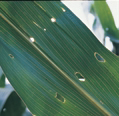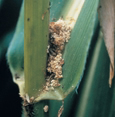
Scouting for European Corn Borer in Bt Corn Fields
So you’ve got the European corn borer (ECB) refuge requirements memorized. 20% of total corn acreage planted to non Bt corn, placing it no more than 1/2 mile away from the Bt field. Growers have done very well at following through on this requirement, set by the Canadian Corn Pest Coalition (CCPC) and the Canadian Food Inspection Agency. Though it might sound silly given how effective Bt corn is at controlling corn borer, but did you know that scouting for injury in your Bt corn fields is also part of the insect resistance management (IRM) strategy? Scouting your fields and alerting us to any unusual corn borer feeding damage in the Bt corn will enable the CCPC to respond quickly to confirm if it is a case of resistance and ensure that resistant populations of corn borer do not continue to spread and cause us to lose the effectiveness of Bt corn in Canada.
ECB scouting should be done twice a season; once when the corn is waist high (First Scouting Trip) and a second time at or shortly after the pollination stage of corn (Second Scouting Trip). It is important to scout the non-Bt refuge areas first so that you know what level of injury is normal for your field, before going into the Bt planting. If the ECB populations are low to begin with in the refuge area, any sort of feeding
may be considered suspicious in the Bt field. Conversely, if the ECB infestation is high in your refuge area, seeing some feeding damage in the Bt corn field may be considered normal, given the circumstances.
Beginning in the refuge area, scout 100 corn plants for every 40 acres of field. For every 10 acres over 40, count an extra 25 plants. (Example 60 acres = 150 plants). Start by scouting 10 plants in a row, located somewhat away from the field’s edge. Assess these 10 plants for any feeding injury. Then move further into the field, selecting another 10 plants in a row. Continue doing this until you have assessed sets of 10 plants in 10 different areas of the field (10x10=100 plants). After the refuge has been scouted, repeat the above procedure in the Bt corn.
| What does ECB injury look like? During the whorl stage of corn, feeding may consist of pinholes and shotholes on the leaves and whorls of plants. The larvae start out so small that they can only feed on the surface of the leaf. As they grow, they can chew holes in the leaves and whorl (Figure 1), eventually tunneling into the midrib and stalk of the plants. |
 Figure 1: Shothole feeding caused by ECB. Photo credit: Marlin Rice, Iowa State University. |
| By the second scouting trip during tassel time, you can see signs of feeding including frass at the leaf axils (Figure 2), bent leaves at the midribs, broken tassels, and lodged plants. |  Figure 2: Frass left by ECB at leaf axil. Photo credit: Marlin Rice, Iowa State University. |
Compare the injury level observed in the non-Bt refuge and the Bt corn hybrid area.
You must contact your corn seed rep or field agronomist if more than 5% of the plants in the Bt corn field are showing any of the following:
| a) | Multiple shot holes and elongated lesions on leaves, and/or | |
| b) | ECB tunneling within the stalk of the plant and/or | |
| c) | Broken tassels, lodging due to ECB tunneling or ear drop due to ECB tunneling. |
The industry rep will confirm that the suspicious plants are indeed Bt plants and that the injury was caused by ECB. He/she will then contact key members of the CCPC who will implement further steps in the resistance management protocols to ensure that we do not lose this valuable technology for future use.
If you are looking for more information on ECB and the IRM strategies, visit the Canadian Corn Pest Coalition website at www.cornpest.ca